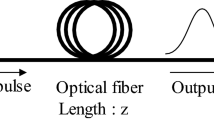Abstract
The Very Large Telescope Interferometer [1,13] will be operated in air which will introduce small optical path fluctuations due to internal turbulence [4,6] and dispersion effects. Both may contribute to fringe contrast decrease. Longitudinal dispersion effects can be corrected by inserting an appropriate glass of variable thickness in one arm of the interferometer [3,5,11,12]. This paper presents a new method applied to VLTI in order to select the optimum glass, according to both the observing wavelength and the spectral bandpath, and to calculate its thickness. Results are presented in terms of improvement on the fringe contrast.
Similar content being viewed by others
References
J.M. Beckers, “Planning the VLT interferometer”, The Messenger, No 60, ESO, 1990
J. Gay et al., ‘L.A.M.P: a concept for the E.S.O VLTI fringe sensor”, SPIE Vol.2200 Amplitude and Intensity Spatial Interferometry, Hawaii, 1994.
L. Koechlin, “The I2T Interferometer”, NOAO/ESO Conference on High resolution imaging by interferometry, Garching, Germany, 15–18 March 1988.
B. Koehler et al. “Engineering aspects of the environmental factors affecting the VLTI performance”, SPIE Vol.2200 Amplitude and Intensity Spatial Interferometry, Hawaii, 1994.
M.Lacasse, “Glass compensation for an air filled delay line“, NOAO/ESO Conference on High resolution imaging by interferometry, Garching, Germany, 15–18 March 1988.
S. Lévêque et al. “Measurement of optical path fluctuations due to internal seeing for the VLTI”, SPIE Vol.2566 Advanced Imaging Technologies and Commercial Applications, San Diego, 1995.
Merck Ltd glass catalogue, Poole BH12 4NN, England “Crystran, Optical crystals”
J.C. Owens, “Optical refractive index of air: dependence on pressure, temperature and composition”, Applied Optics, vol 6, No 1, January 1967, p. 51
Schott-Glass catalogue, 6500 Mainz, Germany, ”Optical Glass catalogue”
W.H Steel, “Interferometry”, Cambridge university press, second edition, 1983.
W.J. Tango, “Dispersion in stellar interferometry”, Applied Optics, vol. 29, No. 4, 1990, p. 516
T.A. Ten Brummelaar, “Differential path considerations in optical stellar interferometry”, Applied optics, vol. 34, No. 13, 1995, p. 2215
O. von der Lühe et al. “The interferometric mode of the ESO VLT”, SPIE Vol.2200 Amplitude and Intensity spatial Interferometry, Hawaii, 1994.
Author information
Authors and Affiliations
Rights and permissions
About this article
Cite this article
Lévêque, S., Koehler, B. & von der Lühe, O. Longitudinal dispersion compensation for the Very Large Telescope Interferometer. Astrophys Space Sci 239, 305–314 (1996). https://doi.org/10.1007/BF00645784
Issue Date:
DOI: https://doi.org/10.1007/BF00645784



